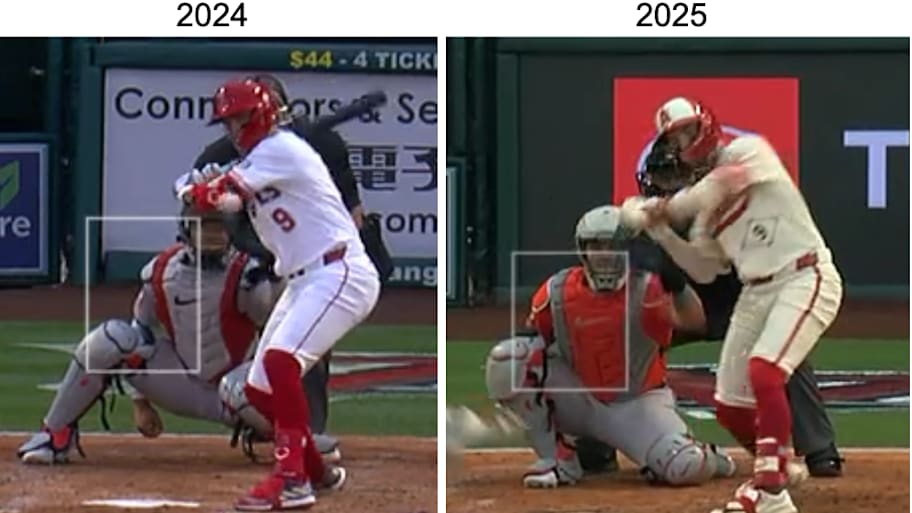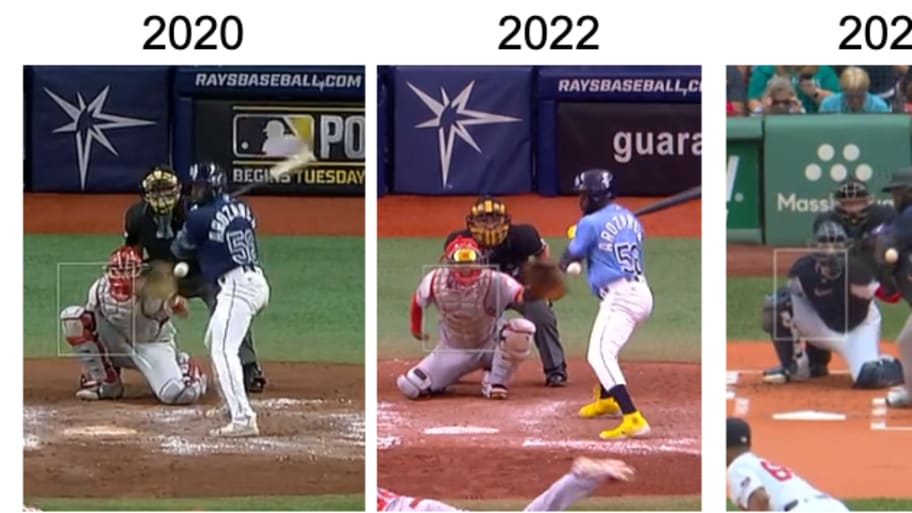The hit by pitch has become so common—and dangerous—that twice last week benches cleared on hits by pitches that were unintentional. Even accidental plunkings are putting hitters in a fighting mood.
The Padres and Dodgers confronted each other Thursday after Fernando Tatis Jr. was hit by a 27-year-old pitcher making his major league debut in a 5–0 game. San Diego manager Mike Shildt touched off the bench-clearing episode when he stormed out of the dugout toward Los Angeles manager Dave Roberts.
“Intentional, unintentional, the fact of the matter is I took exception to it,” said Shildt after watching Tatis get hit for a fourth time in seven games by the Dodgers. He’s been hit once in all other games.
The next night, the Angels and Astros went at it after Angels shortstop Zach Neto took exception to getting hit by a Hunter Brown sinker for the second time in two years.
“I know he’s not trying to hit me,” Neto said, “but it’s definitely frustrating.”
Benches clear between the Angels and Astros
— FOX Sports: MLB (@MLBONFOX) June 21, 2025
(via @PitchingNinja)pic.twitter.com/iJhO7xtg1P
Since spring training, Chris Taylor (hand), Sean Murphy (rib), Thairo Estrada (wrist), Andrew Benintendi (hand), Jake Cronenworth (ribs), Paul DeJong (nose), Joc Pederson (hand) and Luke Keaschall (forearm) all suffered broken bones on pitches. Stars such as Corbin Carroll, Bryce Harper and Christian Yelich were fortunate to avoid major injuries on scary hits by pitches.
What’s going on with hits by pitches? Are hitters getting too sensitive? Is this the price for pitchers getting rushed to the big leagues? Are injuries forcing pitchers into the big leagues when they don’t belong there?
It’s time to set aside the myths and sloppy narratives. Let’s examine the facts of the hit by pitch epidemic to find out what’s going on.
1. Hitting has never been more dangerous than these past eight seasons.
The eight seasons with the highest rates of hit by pitches since 1901 are, in order, 2020, 2023, 2021, 2024, 2022, 2019, 2025, 2018. Notice a trend? In 117 seasons from 1901 to 2017 the hit by pitch rate never reached 0.8 per game (both teams combined). Now it has done so eight straight years. (That’s also before and after the sticky stuff crackdown.)
Hits by pitches have become so common and dangerous, it is rare to see a player go to the plate without some kind of armor on their hands, wrists, arm or elbow.
2. The biggest factor in the rise of hits by pitches is the rise of pitch-shaping.
The trend toward lab-grown pitches (tweak their shape and spin) has overtaken pure velocity as the guiding force of pitching. Most pitchers now want to move the ball to both glove side and arm side. That has given rise to more same-side sinkers (i.e., right-on-right two-seamers running in) and off-side cutters (i.e., right-on-left cutters).
Of the 914 hits by pitches this year through Saturday, more have been caused by sinkers and cutters than any other type of pitch. More telling, the rate of HBP from sinkers and cutters is much higher compared to their overall use. Nothing else is close. Sinkers and cutters account for only 23.4% of pitches but 34.2% of HBPs.
2025 HBP by pitch type
“I don’t think [pitchers] pitch in as much as they used to,” says Rangers manager Bruce Bochy, the dean of active managers who is in his 28th season. “So, they don’t quite have that command for that pitch. And a lot of it is elevated in, too. You pitch on that top rail, in with the sinker that gets away from you a little bit, you’re gonna hit somebody. Those are the scary ones.”
3. The youngest pitchers are not the worst culprits.
Pitchers 25 and under hit batters at a 7% lower rate than pitchers 26 to 30 years old.
Hit by Pitch rate by age of pitcher, 2025
4. That said, there is a general correlation between age and control.
Pitching control metrics by age, 2025
5. Hitters share the blame.
Brown yelled back at Neto that standing close to the plate and “diving” into a pitch puts a hitter in harm’s way. He is not wrong.
Here are the two right-on-right sinkers from Brown that hit Neto:

Those pitches are only 6½ inches off the inside corner of the strike zone, about the width of two baseballs. Neto’s feet are close to the plate and his hands are above the plate as he starts to bring the barrel around.
Where does a hitter look for the baseball? Here’s a clue: 59% of pitches are on the outer half of the plate or farther out. Combine that prevalence with the widespread adoption of body armor and you have hitters dismissing the pitch in.
“I don’t think they’re even concerned about it,” Bochy says. “When these hitters are going to game plan, a lot of times they’re looking out over the plate. There's no fear.
“Guys pitched in more than I think what they do now. And these [hitters], they’re just diving. I mean, we have some guys doing it, too. You saw Josh Jung break his wrist [last year]. Guys used to turn or move [away]. But now they’re going right into the pitch. Some guys just have a hard time turning out of the way versus getting their hands going there a little bit.
“You’ve got these pitchers now throwing so hard with that ball running in or that cutter … that cutter is a big pitch and it’s hitting a lot of these guys because they’re committing and then they’re just going right into it.”
6. Randy Arozarena of the Seattle Mariners is the best example of the collision of these pitching and hitting changes.
Arozarena leads the majors in hit by pitches with 13 (tied with Ty France). One pitch clipped his hand and 11 have hit his elbow guard. Six of them have come on right-on-right sinkers.
He has been hit 84 times in his career. Seventy-five of those HBPs (89%) have been above the waist and below the shoulder—mostly off his elbow guard.
Since he first came up in 2019, Arozarena has moved closer to the plate and learned how to keep his protected front elbow in the path of the pitch rather than avoiding it. Here are pitches off his elbow guard over the years where you can see he moved closer to the plate with his feet and, thus, his elbow:

7. Tatis was hit by pure misfires from Lou Trivino and Jack Little.
Those pitches were 24.5 and 15 inches off the inside corner of the plate, respectively.

Shildt overreacted because he doesn’t want to lose his impact hitter to a broken bone caused by bad pitching. Intent didn’t matter. Major league hitters expect major league pitchers to have major league command. Sometimes pitches get away.
Like many modern hitters, Tatis starts with an open stance and steps into the baseball. Over his career, he has been hit 18 times by pitches from righthanders; eight of them on sinkers.
Said a rival manager, “Tatis, you have to pitch him in. I know they’re tired of him getting hit. But, hell, what’s your option? Keep throwing him away and give up damage? Or try to get him out? I don't think anybody was trying to hit him, but he gets hit a lot.”
8. The HBPs of Shohei Ohtani by San Diego, both after Tatis was hit, looked intentional.
Randy Vasquez hit Ohtani in the thigh with a four-seamer on Tuesday, after just missing him with the previous pitch, also a four-seamer. It was only the third lefthanded hitter Vasquez hit in his career with a four-seamer, the first time on a pitch that high.
Now Shohei Ohtani is hit and Robert Suarez gets tossed pic.twitter.com/3zjJqQtBTp
— Jomboy Media (@JomboyMedia) June 20, 2025
Two days later, Robert Suarez also hit Ohtani with a fastball. Suarez has thrown 831 four-seam fastballs to lefthanded hitters. The one to Ohtani was the farthest inside of all of them.
Suarez has hit only three lefthanded batters with his fastball in his career. The other two occurred in his rookie season, three years ago.
The count was 3-0. It happened in the bottom of the inning just after Little pegged Tatis.
Cool cat that he is, Ohtani shrugged, took first base without complaint and waved to his teammates the equivalent of, “Let’s move on; nothing to see here.”
MLB deemed it intentional and suspended Suarez three games. Suarez denied it was intentional.
9. Injuries and analytics-based game management have put hundreds more pitchers in the big leagues who about a decade ago would still be in the minor leagues honing their craft.
Just short of halfway through this season, MLB teams already have used more pitchers than in the 141 entire seasons between 1874 and 2014.
The 19th century, I get. But just think about this when you want to understand how fast the game has changed: teams have used more pitchers less than halfway through this season (709) than they did the entire season just 11 years ago (692).
More MLB on Sports Illustrated
This article was originally published on www.si.com as Here’s What’s Really Happening With MLB’s Hit-by-Pitch Epidemic.
